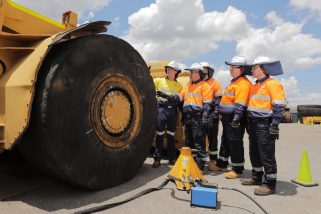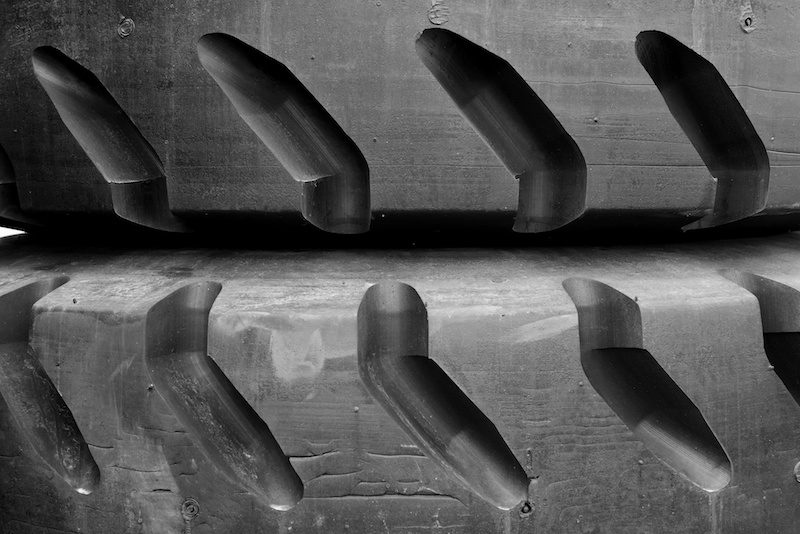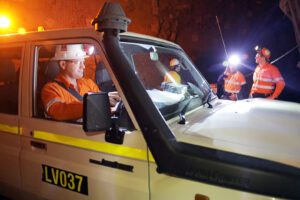To get to the heart of what makes a great tyre safety program at a mine site, AMSJ spoke with Greg Glennon, an experienced operations manager in the tyre industry. Greg recently spoke at last year’s Queensland Mining Industry Health and Safety conference and provided valuable insight into his company’s approach to safety including the identification and management of critical risks. Greg also spoke about ways in which innovative rewards and recognition programs drive safety solutions from the frontline. We put some questions to Greg about how the industry can benefit from improved tyre safety programs.
AMSJ We’ve seen recently another tyre related fatality in the industry recently and, over the years there’s been a number of tragic incidents, why do you believe the issue has been an ongoing one in the industry?
GREG There has been an unacceptable number of fatalities in the industry, despite a fairly good knowledge of the causes and controls to prevent them. When there is a fatality in the industry, tragically it is rare that we would say we didn’t know that risk existed, but for one reason or another, the known controls were either not in place, or in-effective, on the day the event occurred.
The risk of a fatality during a tyre maintenance activity on an Australian mine site is in the order of ten times higher than that for a non-tyre related vehicle maintenance event.
There are a number of different critical risk scenarios involving tyres and the majority of these historic fatalities involve non-Tyre Technicians, which highlights the need to have adequately trained tyre maintenance personnel undertaking tyre work and robust work procedures and systems to support them.
AMSJ What’s been your approach to managing tyre related risks?
GREG We have used the International Council on Mining and Metals (ICMM) Health and safety-critical control management: Good practice guide to assist us in developing our critical risk management program. The first point of call was to define the scenarios that could result in a fatality and identify the key critical controls; which are highly relied upon to prevent a fatality. Then we put a significant amount of energy into working out what can erode the effectiveness of each of these controls and built a series of checks in to our system to regularly ensure these key controls are in place as work is happening and that the systems that support them are effective.
AMSJ What are the key elements of an effective tyre safety management program?
GREG There’s a few:
- Senior management must be committed to creating and maintaining systems that support safety
- Choosing the right people to work for the company and then standardising the training they receive.
- Ensuring operational leaders have the skill set to be HSE leaders in the field.
- Developing Best Practice Procedures and systems that are in place and continually refine them in consultation with the Tyre Technicians.
- A comprehensive critical risk management program to prevent fatalities.
AMSJ How have you guys gone about building a best practice approach to tyre safety management? Has it been easy? What have been the challenges along the way?
GREG We have heavily invested in training quality tyre professionals for the industry. My company has a Registered Training Organisation certified to deliver training, assess competencies and issue qualifications recognised within the Australian Quality Training Framework. At the core of our innovative training program is our Tyre Training Centre in Perth, Western Australia – built to reinforce our culture of Zero Harm and Critical Risk Management. The Training Centre comprises a simulated mine tyre pad and workshop and is equipped with both open cut and underground mining equipment. This level of investment is substantial, but one we believe makes a difference in the way we consistently deliver our services and maintain our safety performance.
We also have also focussed on building partnerships with our clients to overcome challenges specific to their operations together. Buy-in from the client is essential to maintaining a functioning critical risk program. The program evolves over time and needs the clients’ commitment as well.
AMSJ Are there any hazards that we can’t control? and why?
GREG We have been developing our procedures known as Best Practices (or OBPs for short) for over 45 years. Over that time they have been updated to reflect the best practice available at that point in time. As incidents occur either within or outside of our organisation, we refine our OBPs to ensure the safest possible procedures are available with corresponding controls and mitigation processes should an event occur. The issue will always be the ‘unforeseen’, that situation which eventuates when a series of circumstances combine to produce an incident. Unfortunately, there may be an opportunity for this to occur however we strongly believe we have our critical risks well understood.
AMSJ What types of technology might contribute to a tyre safety management program?
As it is for any industry-wide system, IT software is a large component of a well-designed program. A simple reactive, program can be run from a basic spreadsheet. A comprehensive management program needs to provide a number of key offerings to users in a web-based format. These need to be features that make it easy to use, accessible on a wide range of platforms such as a laptop, iPad, mobile and provide reports available to key parts of the business including maintenance, accounting and procurement.
Other components that are forming a key part of the ‘nuts and bolts’ of tyre management are tyre pressure monitoring systems (TPMS) and the use of nitrogen. TPMS will add another level of understanding of the behaviour of an operating tyre in real time, whilst nitrogen is being used in more industries to provide improved safety through a reduction in the risk of tyre explosion. Consideration of both of these should form part of a complete program.
AMSJ Are there any industries outside mining that have the same issues with tyre safety management and how do those industries address the issues?
GREG The focus for tyre management has been predominantly on Off The Road (OTR) tyres in the mining industry. This is likely due to a number of reasons: 1. The expense of an OTR tyre, for the larger trucks being $50-60,000 each; 2. The earning ability of a mining truck particularly when commodity prices are at high levels; 3. The huge forces present if a tyre fails catastrophically and the potential to injure or kill. Tyre management programs exist for other industries such as road freight, bus lines and quarries with a large number of providers available to industry.
AMSJ What are the trade-offs? Obviously, it’s costly for any organisation to implement an effective tyre safety program and it can add cost to your service and product. Do you believe that there is a recognition in the industry that these costs are worth something?
GREG Case studies are our best tool when offering a financial justification for the program. For mining, the cost of the introduction of a program is not large relative to the expense of operating an ultra-class fleet. Historical data can be used to compare with an existing operation and can provide a realistic recommendation on the validity of a program. A conversation with a provider is worthwhile as a starting point and the cost-benefit payoff for the company.
 AMSJ Are there any productivity links to having an effective tyre safety management program?
AMSJ Are there any productivity links to having an effective tyre safety management program?
GREG True management rather than reactive change only will always deliver improved productivity. As they say, ‘if you can measure it, you can manage it’. We spend a lot of time gathering data, measuring temperature, pressure, tread depths, inspecting road conditions and recommending improvements to operations. We look at payload and loading practises and deliver tyre awareness training sessions to management and operators. All of these form part of the program that supports the targets of the operation for productivity improvements and cost reduction.
The ‘low hanging fruit’ of a program is a substantial reduction in downtime achieved early in the start-up of a fully embedded program that includes tyre technicians and engineering. Reduced downtime has obvious benefits of improved productivity. The flow on from safe and efficient tyre changing practices and an engineering focussed tyre management program could take 12 months to eventuate however will deliver long term gains that can be quantified easily. This evident through our existing clients many of whom have been with us for over 10 years and one for 45 years.
You can view Greg’s presentation at https://qmihsc2018.evertechnology.com/conference-session/tyre-maintenance-critical-risk/
 For more information contact Greg Glennon on +61 467 734099 or email gregory.glennon@otraco.com
For more information contact Greg Glennon on +61 467 734099 or email gregory.glennon@otraco.com
This article first appeared in the Summer 2019 Editions of Australasian Mine Safety Journal.
Read more Mining Safety News














Add Comment